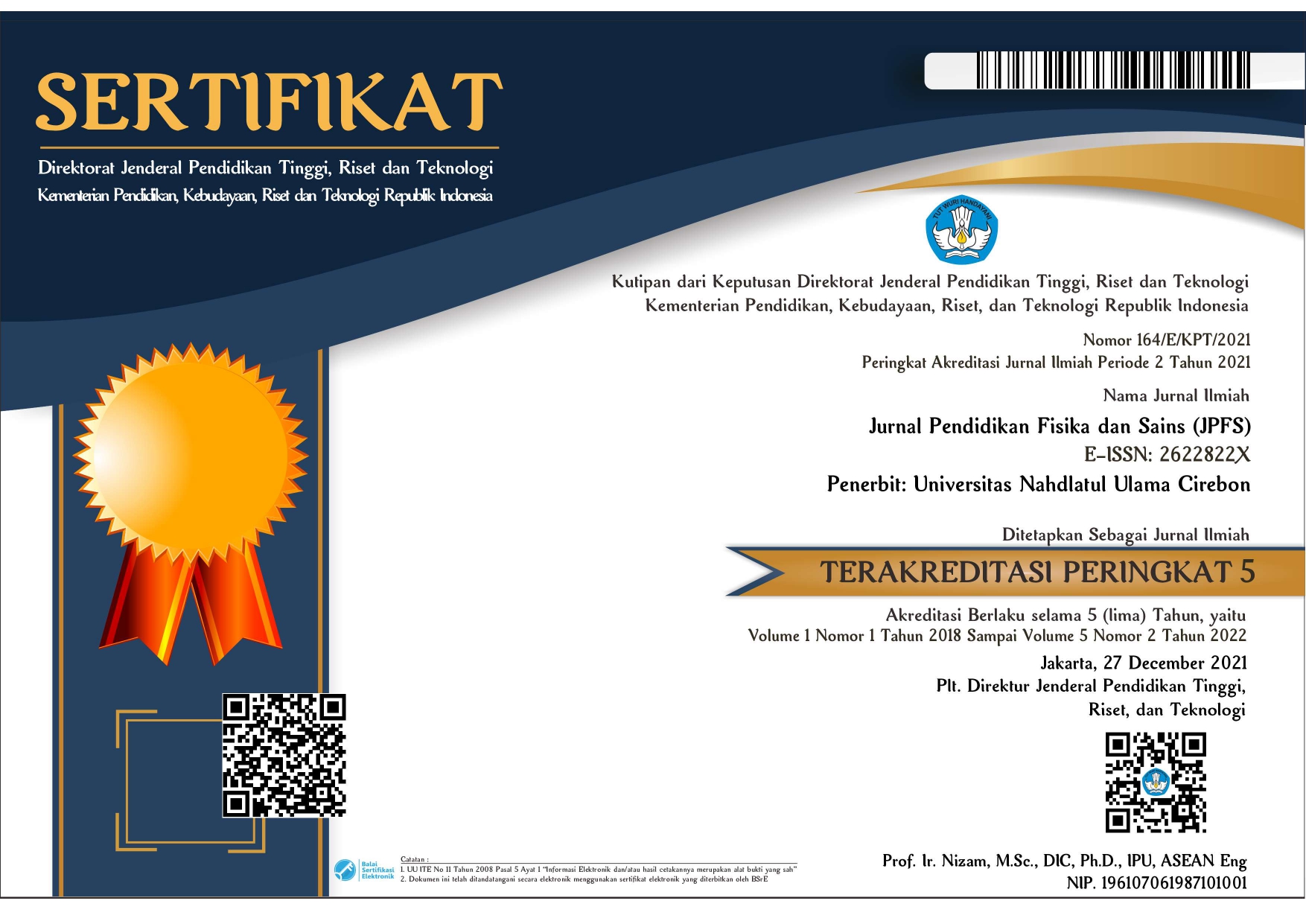Analisis Pengaruh Massa Beban Terhadap Koefisien Redaman Menggunakan Software Python
DOI:
https://doi.org/10.52188/jpfs.v7i1.703Keywords:
Damping Coeffisien, Load Mass, Damped Oscillation, Machine LearningAbstract
This research aims to determine the effect of load mass on the damping coefficient value. The method used in this research is an experimental method where loads with varying masses of 100gr, 120gr, and 140gr are oscillated into three types of liquid, namely water, our oil, and tropical oil. The analysis is based on damped oscillations using Python software which aims to process the data because with the training model in it it is hoped that it will be able to provide more accurate results. Based on the results of data analysis, the damping coefficients (b) for water, minyak kita oil, and tropical oil are respectively (0.0412, 0.0505, 0.0533), (0.1068, 0.1181, 0.1364), and (0.1035, 0.1299, 0.1436). These results indicate that the greater the mass of the load, the greater the resulting damping coefficient.
References
Acu, Y., Lapanporo B. P., & Kushadiwijayanto A. A. (2017). Model Sederhana Gerak Osilator dengan Massa Berubah Terhadap Waktu Menggunakan Metode Runge Kutta. POSITRON,7(2), 42. https://doi.org/10.26418/positron.v7i2.23276
Aulia, M. R., Zannah, N., Zakiah, S., Darajat, A., Atmojo, T., & Karina, W. (2018). OSILASI TEREDAM PADA PEGAS DENGAN MEDIUM FLUIDA. JoTaLP: Journal of Teaching and Learning Physics, 3, 22–26. https://doi.org/10.15575/jtlp.v3i1.65479
Azmi, U., Hadi, Z. N., & Soraya, S. (2020). ARDL METHOD: Forecasting Data Curah Hujan Harian NTB. Jurnal Varian, 3(2), 73–82. https://doi.org/10.30812/varian.v3i2.627
Giancoli, D. C. (2005). Physics Principles with Application. In Pearson Education, Inc (6th ed., pp. 287–300). Pearson Education, Inc.
Halliday & Resnick. (2011). Fundamentals of Physics. 9th Edition.
Hendarwati, E. K., Lepong, P., & Suyitno. (2023). Pemilihan Semivariogram Terbaik Berdasarkan Root Mean Square Error (RMSE) pada Data Spasial Eksplorasi Emas Awak Mas. Jurnal Geosains Kutai Basin, 6(1), 2023.
Kusuma, P. D. (2020). Machine Learning; Teori, Program, dan Studi Kasus. In CV Budi Utama. CV Budi Utama.
Mukharomah, F., Mutiarani, A., Supiyadi, & Sulhadi. (2021). Gerak Harmonik Teredam untuk Menentukan Koefisien Viskositas Fluida Berbantuan Software Tracker Video. WaPFi (Wahana Pendidikan Fisika), 6(1). https://physlets.org/tracker/.
Selvira, C. A., Subaedi, A. N., Azzahra, N. A., Novitasari, O., & Antarnusa, G. (2020). Meningkat Keakuratan Simulasi Osilasi Harmonik Teredam pada Pegas Menggunakan Tracker Video Analysis and Modelling Tool. In Prosiding Seminar Nasional Pendidikan Fisika (Vol. 3, Issue 1). https://jurnal.untirta.ac.id/index.php/sendikfi/index
Serway, R. A., & Jewett, J. W. (2004). Physics for Scientists and Engineers . In Physics for Scientists and Engineers (6th ed.). Thomson Brooks/Cole.
Serway, R. A., & Jewett, J. W. (2008). Physics for Scientists and Engineers with Modern Physics . In Thomson Higher Education (7th ed., pp. 418–447). Thomson Higher Education.
Susilo, A., Yunianto, M., & Variani, V. I. (2012). Simulasi Gerak Harmonik Sederhana dan Osilasi Teredam pada Cassy-E 524000. In Indonesian Journal of Applied Physics (Vol. 2, Issue 2).
Tirtasari, Y., Dzar, F., Latief, E., & Amahoru, A. H. (2016). Penggunaan Teknik Video Tracking Untuk Mengamati Fenomena Osilasi Teredam Pada Pegas. Prosiding SNIPS.
Young & Freedman. (2008). University Physics with Modern Physics. In Pearson Addison Wesley (12th ed., pp. 456–485). Pearson Education International.
Zhu, M., Wang, J., Yang, X., Zhang, Y., Zhang, L., Ren, H., Wu, B., & Ye, L. (2022). A review of the application of machine learning in water quality evaluation. Eco-Environment & Health, 1(2), 107–116.
Published
How to Cite
Issue
Section
Copyright (c) 2024 Stevi Silahooy, Delpina Nggolaon, Aufa Maulida Fitrianingrum

This work is licensed under a Creative Commons Attribution 4.0 International License.
Copyright Transfer Agreement
The Authors submitting a manuscript do so on the understanding that if accepted for publication, copyright of the article shall be assigned to Jurnal Pendidikan Fisika dan Sains (JPFS) and Physics Education Programs of UNU Cirebon as publisher of the journal.
Copyright encompasses exclusive rights to reproduce and deliver the article in all form and media, including reprints, photographs, microfilms and any other similar reproductions, as well as translations. The reproduction of any part of this journal, its storage in databases and its transmission by any form or media, such as electronic, electrostatic and mechanical copies, photocopies, recordings, magnetic media, etc. , will be allowed only with a written permission from Jurnal Pendidikan Fisika dan Sains (JPFS) and UNU Cirebon.
Authors are permitted to disseminate published articles by sharing the link/DOI of the article at the journal. Authors are allowed to use their articles for any legal purposes deemed necessary without written permission from the journal with an acknowledgment of initial publication to this journal.
Jurnal Pendidikan Fisika dan Sains (JPFS) and UNU Cirebon and the Editorial Board make every effort to ensure that no wrong or misleading data, opinions or statements be published in the journal. In any way, the contents of the articles and advertisements published in the Jurnal Pendidikan Fisika dan Sains (JPFS) are sole and exclusive responsibility of their respective authors and advertisers.






















